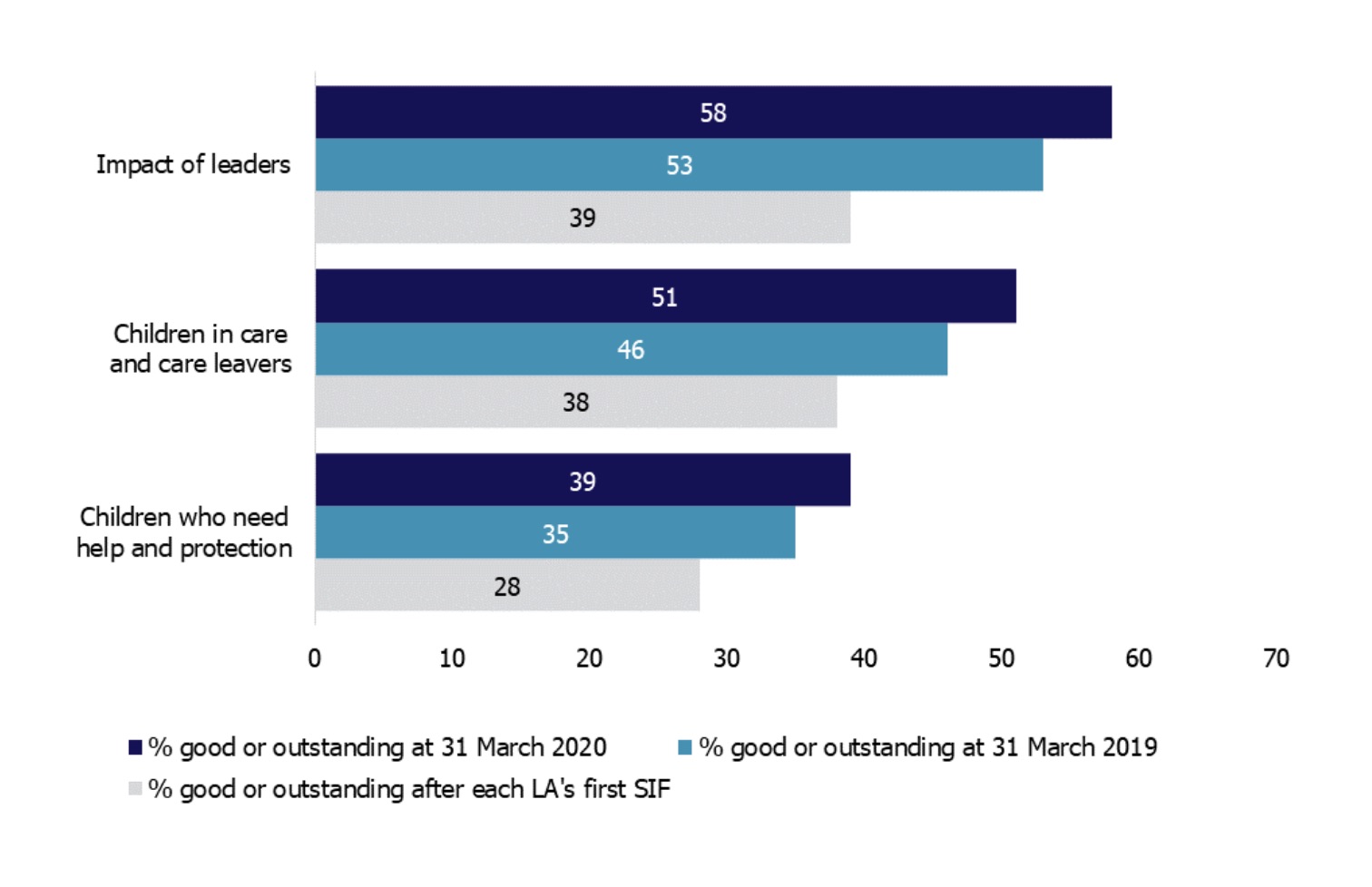
Article updated 8 July
Local authority services for children in need of help and protection continue to lag behind other functions assessed by Ofsted, the inspectorate’s annual children’s social care report has shown.
The 2020 statistical release contained mostly positive news in terms of the performance of children’s services delivered by councils, along with a small number of independent trusts.
Across all English local authority areas, 50% were rated ‘good’ or ‘outstanding’ as of 31 March 2020, up from 46% the previous year and just 36% in October 2017, when each authority had first been graded under the old single inspection framework (SIF). Since 2018, the SIF has been superseded by the inspections of local authorities’ children’s services (ILACS) framework.
Each of the individual measures Ofsted uses to build its overall grade – services for children in need of help and protection, and for children in care and care leavers, along with the impact of leaders – has also improved over that time.
But while 58% of authorities were rated ‘good’ or ‘outstanding’ for leadership at the end of March, as were 51% for services for children in care and care leavers, the same was true for only 39% of authorities in respect of services for help and protection.

Percentage of good or outstanding judgments after each LA’s first SIF inspection and at 31 March 2019 and 2020 (credit: Ofsted)
Across the country, just 11 local authorities (7%) are rated ‘outstanding’ for their child protection services.
Two-grade rises
Over the year to 31 March – which was shortened by two weeks due to coronavirus – Ofsted conducted 59 ILACS standard or short inspections, with 49% being judged ‘good’ or ‘outstanding’, 34% ‘requires improvement to be good’ and 17% ‘inadequate’.
Feeding the overall improving picture, 26 of local authorities saw their inspection grade improve, with four of them – Barnet, Croydon, Tower Hamlets and Telford and Wrekin – rising by two grades. Nineteen meanwhile remained steady while 14 declined.
Ofsted also carried out 41 focused visits, which home in on particular service areas and can trigger full inspections, to 39 local authorities.
In keeping with the findings around services for children in need of help and protection, 37% of these visits focused on children in need or subject to a protection plan, while 32% examined councils’ front-door provision.
Responding to the findings, the chair of the Association of Directors of Children’s Services’ standards, performance and inspection policy committee, Steve Crocker, said: “The statistics show that in the judgement of ‘children in need of help and protection’, 11 local authorities are now judged to be outstanding, up by 4 local authorities since 31 March 2019. Although the overall percentage of local authorities judged outstanding in this category might be lower than we would hope, there has been progress since last year.
“However, we cannot be complacent. Child protection is complex, made even more challenging by growing levels of need and significantly underfunded children’s services. ADCS is clear, we need proper, sustainable and equitable investment in children and the full range of services they rely on. This is even more important in a world with Covid-19.”
Outside of core local authority children’s services, the number of children’s homes continued to rise over the year, by 7% to 2,460, with overall places increasing by 1% to 12,175, reflecting the trend for smaller homes. The proportion rated ‘good’ or ‘outstanding’ remained constant at 80%.
The concentration of residential care in the North West, where property is cheap, continued, with one in four homes and one in five places being located in the region.
The proportion of new children’s homes operated by local authorities remained steady from the previous year at 10%, despite the overall number of new homes rising from 204 to 286. This saw the overall number of council-run homes rise – from 418 to 423, returning the total to 2018 levels – though this is in the context of years of decline.


 Bournemouth, Christchurch and Poole
Bournemouth, Christchurch and Poole  Hampshire County Council
Hampshire County Council  Lincolnshire County Council
Lincolnshire County Council  Norfolk County Council
Norfolk County Council  Northamptonshire Children’s Trust
Northamptonshire Children’s Trust  South Gloucestershire Council
South Gloucestershire Council  Wiltshire Council
Wiltshire Council  Wokingham Borough Council
Wokingham Borough Council  Children and young people with SEND are ‘valued and prioritised’ in Wiltshire, find inspectors
Children and young people with SEND are ‘valued and prioritised’ in Wiltshire, find inspectors  How specialist refugee teams benefit young people and social workers
How specialist refugee teams benefit young people and social workers  Podcast: returning to social work after becoming a first-time parent
Podcast: returning to social work after becoming a first-time parent  Podcast: would you work for an inadequate-rated service?
Podcast: would you work for an inadequate-rated service?  Family help: one local authority’s experience of the model
Family help: one local authority’s experience of the model  Workforce Insights – showcasing a selection of the sector’s top recruiters
Workforce Insights – showcasing a selection of the sector’s top recruiters 

 Facebook
Facebook X
X LinkedIn
LinkedIn Instagram
Instagram
Comments are closed.